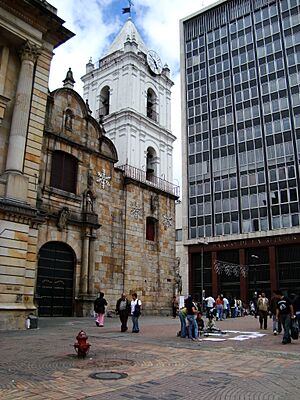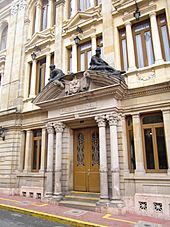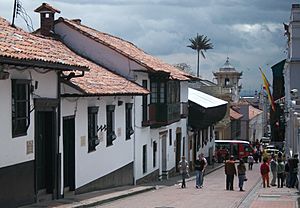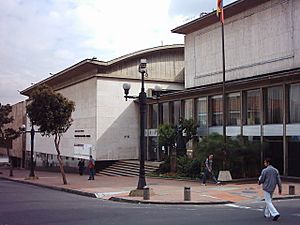La Candelaria, Bogotá facts for kids
Quick facts for kids
La Candelaria
|
|
|---|---|
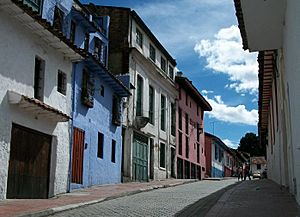 |
|
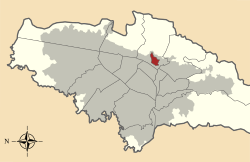
Location of the locality in the city of Bogotá
|
|

Location of the locality in the Capital District of Bogotá
|
|
| Country | |
| City | Bogotá D.C. |
| Area | |
| • Total | 2.06 km2 (0.80 sq mi) |
| Elevation | 2,600 m (8,500 ft) |
| Population
(2007)
|
|
| • Total | 22,115 |
| • Density | 10,735/km2 (27,800/sq mi) |
| Time zone | UTC-5 (Colombia Standard Time) |
La Candelaria is a super old and important neighborhood in Bogotá, Colombia. It's like the "Old City" of Bogotá, full of history and amazing buildings. You'll see cool Spanish Colonial, Baroque, and art deco buildings here.
This area is home to many universities, libraries, and museums. It's where Bogotá was first founded way back on August 6, 1538. Today, La Candelaria is a busy spot for tourists, students, and businesses. It includes neighborhoods like La Catedral, Las Aguas, and Nueva Santa Fe.
Contents
A Glimpse into La Candelaria's Past
The area known today as Chorro de Quevedo was once a special resting place for the Muisca ruler, the Zipa. The Zipa was a powerful leader of the Muisca people, who lived in this region long before the Spanish arrived.
It's believed that a Spanish explorer named Gonzalo Jiménez de Quesada founded Bogotá right here on August 6, 1538. The town was later named after the old Church of Nuestra Señora de la Candelaria.
In April 1539, the city was officially established in what is now Plaza de Bolívar. This central square became the heart of the city. It was also the site of the main church, which is now the Metropolitan Basilica Cathedral.
Over time, Bogotá grew outwards from this central spot. The Plaza Mayor and the Cathedral always remained important. They were the main places for colonial and later government power.
In the 1970s, people realized how special La Candelaria's history was. They created a group to help protect its old buildings and heritage. In 1974, La Candelaria became its own special area within Bogotá. By 1991, it was officially recognized as one of Bogotá's 20 main districts.
Awesome Places to Explore
La Candelaria is packed with cool places to visit. It's where you'll find the famous Plaza de Bolívar, the city's main square.
Around the Plaza de Bolívar, you can see important government buildings. These include the Capitolio Nacional, where Colombia's laws are made. There's also the Palace of Justice, where important legal decisions happen. The Palacio Liévano is where Bogotá's mayor works.
You'll also find the impressive Primatial Cathedral of Bogotá and the Archbishop's Palace nearby. The Casa de Nariño is the home and office of Colombia's President.
Fascinating Museums
La Candelaria has many museums where you can learn about art and history.
- The Bank of the Republic has several museums, including the Mint House. Here you can learn about how money was made.
- The Museo Botero displays amazing art by Fernando Botero and other famous artists like Monet and Picasso.
- The Museum of Colonial Art shows art from Colombia's past.
- The National Police Museum is also here.
Cool Cultural Spots
- The Luis Ángel Arango Library is one of the biggest libraries in Latin America. It has over a million books! It also hosts talks and art shows.
- The Gabriel García Márquez Cultural Center is another great place for culture.
- You can also visit the birthplace of Rafael Pombo, a famous Colombian writer.
Historic Churches
La Candelaria is home to many beautiful old churches.
- The Primatial Cathedral of Bogotá is the main church in the city.
- The Chapel del Sagrario is right next to the Cathedral.
- The National Sanctuary of Nuestra Señora del Carmen is known for its unique striped facade.
- Other notable churches include the San Ignacio Church and the Church of San Agustín.
Top Universities
Many universities have their main campuses in La Candelaria. This makes the area a lively place for students. Some of these include Los Andes, La Salle, and Del Rosario.
Unique Streets and Landmarks
- Calle del Embudo: This narrow, colorful street is shaped like a funnel. It's famous for its amazing street art and graffiti. Many paintings show old legends from before the Spanish arrived. It leads to the Plaza del Chorro de Quevedo.
- Plaza del Chorro de Quevedo: This square is believed to be where Bogotá was founded in 1538. It's named after a priest who put a public water fountain here in 1832. Today, it's a popular spot for people to gather.
- Botero Museum: This museum shows off works by the famous Colombian artist Fernando Botero. You can also see paintings by other world-renowned artists from Botero's own collection.
- Gold Museum: This is one of Colombia's most important museums. It has over 36,000 incredible pieces made of gold, wood, and stone from ancient times.
- Colón Theater: This beautiful theater was built in 1892. It has a classic style and can hold 900 people for shows.
- Monserrate: This mountain is a symbol of Bogotá. You can see it from almost anywhere in the city! There's a church and a restaurant at the top. You can get there by cable car, funicular, or by hiking up.
- La Puerta Falsa: This shop is over 200 years old! It's famous for its delicious hot chocolate and traditional Colombian tamales.
Climate in La Candelaria
La Candelaria has a cool, mild climate all year round because it's high up in the mountains. The average temperature is around 13°C (55°F). It can rain quite a bit, especially from March to May and October to November. Even so, there are still many sunny days to enjoy exploring this historic area.
| Climate data for La Candelaria (Venado Oro Vivero), elevation 2,725 m (8,940 ft), (1971–2000) | |||||||||||||
|---|---|---|---|---|---|---|---|---|---|---|---|---|---|
| Month | Jan | Feb | Mar | Apr | May | Jun | Jul | Aug | Sep | Oct | Nov | Dec | Year |
| Mean daily maximum °C (°F) | 19.6 (67.3) |
18.9 (66.0) |
18.8 (65.8) |
18.7 (65.7) |
18.6 (65.5) |
18.1 (64.6) |
17.5 (63.5) |
17.7 (63.9) |
18.3 (64.9) |
18.3 (64.9) |
18.3 (64.9) |
18.8 (65.8) |
18.4 (65.1) |
| Daily mean °C (°F) | 12.9 (55.2) |
13.1 (55.6) |
13.3 (55.9) |
13.4 (56.1) |
13.2 (55.8) |
13.0 (55.4) |
12.5 (54.5) |
12.6 (54.7) |
12.8 (55.0) |
12.9 (55.2) |
12.8 (55.0) |
12.8 (55.0) |
13 (55) |
| Mean daily minimum °C (°F) | 7.9 (46.2) |
8.5 (47.3) |
9.0 (48.2) |
9.5 (49.1) |
9.7 (49.5) |
9.4 (48.9) |
9.0 (48.2) |
8.6 (47.5) |
8.6 (47.5) |
8.7 (47.7) |
8.9 (48.0) |
8.1 (46.6) |
8.9 (48.0) |
| Average precipitation mm (inches) | 70.6 (2.78) |
74.6 (2.94) |
107.3 (4.22) |
125.5 (4.94) |
129.0 (5.08) |
72.8 (2.87) |
70.3 (2.77) |
64.0 (2.52) |
59.9 (2.36) |
128.6 (5.06) |
142.8 (5.62) |
89.4 (3.52) |
1,134.6 (44.67) |
| Average precipitation days | 8 | 11 | 14 | 17 | 20 | 21 | 21 | 20 | 15 | 17 | 17 | 13 | 183 |
| Average relative humidity (%) | 80 | 80 | 81 | 82 | 83 | 82 | 82 | 81 | 80 | 82 | 83 | 81 | 81 |
| Mean monthly sunshine hours | 124.0 | 101.6 | 89.9 | 75.0 | 83.7 | 93.0 | 102.3 | 108.5 | 93.0 | 80.6 | 75.0 | 102.3 | 1,128.9 |
| Mean daily sunshine hours | 4.0 | 3.6 | 2.9 | 2.5 | 2.7 | 3.1 | 3.3 | 3.5 | 3.1 | 2.6 | 2.5 | 3.3 | 3.1 |
| Source: Instituto de Hidrologia Meteorologia y Estudios Ambientales | |||||||||||||
See also
 In Spanish: La Candelaria para niños
In Spanish: La Candelaria para niños
- La Calera, Cundinamarca, a town not far from Bogotá, through the Eastern Hills.


